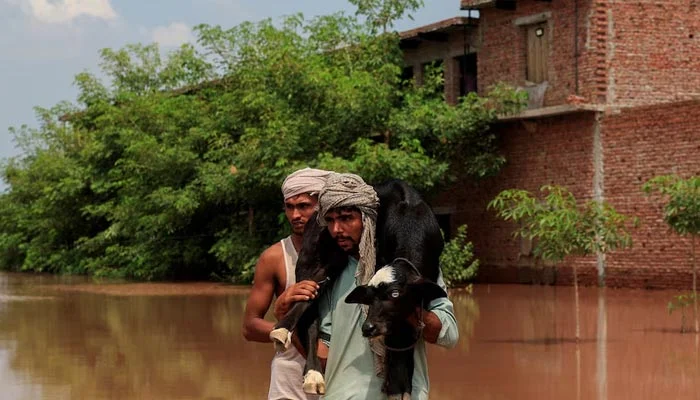Punjab Floods Affect Over 2 Million People; Thousands of Villages Inundated
ISLAMABAD / PUNJAB: More than 2 million people have been affected and over 2,000 villages submerged in Punjab after devastating monsoon floods, according to the Provincial Disaster Management Authority (PDMA). The unprecedented floods have swept away homes, destroyed crops, and drowned livestock, leaving thousands displaced.
Officials say around 760,000 people and 516,000 animals have been evacuated, and at least 33 lives have been lost in less than a week. Relief efforts are ongoing, with 511 relief camps, 351 medical sites, and 321 veterinary facilities set up across the province. Over 15,000 police personnel are assisting with evacuations and security.
Farmers and Livelihoods Devastated
Muhammad Amjad, a rice and potato farmer in Chiniot, shared his loss:
“Thirteen of my 15 acres are completely submerged. Our rice crop is destroyed. Women and children have evacuated, and men are left guarding what remains.”
Amish Sultan, who lost his buffaloes, said:
“I used to earn 100,000–150,000 rupees per month. That income is gone. My children now have no milk, and we are struggling to survive.”
Entire neighborhoods have been washed away, leaving families like that of laborer Mehdi Hassan stranded with whatever they could carry.
Economic and Agricultural Impact
The floods have hit Punjab’s agriculture and exports hard. Rice and cotton, major staples for domestic consumption and international trade, have been severely damaged. Experts warn that rice prices could jump from 3,200–3,600 per 40kg to 5,000–5,500, affecting consumers and reducing Pakistan’s competitiveness globally. Cotton shortages could impact the textile sector, which makes up more than half of Pakistan’s exports.
Agriculture analysts predict that wheat, vegetables, and other crops will also face shortages, creating ripple effects across supply chains and household budgets. Recovery and rebuilding costs are expected to run into billions of rupees.
Relief Efforts Underway
Authorities have set up temporary camps for displaced families. In Lahore, rickshaw driver Aslam described wading through six feet of water to save his livelihood, now living in a relief tent along with hundreds of other families.
Dr. Ijaz Nazeer of Al Khidmat Foundation said 150–200 camps have been established near the Ravi River alone, with each tent sheltering 5–8 people.
Farmers and experts emphasize that support for recovery is critical, warning that failure to assist flood-hit communities could worsen food insecurity nationwide.
“Farmers grow the food that sustains us all,” said activist Aamer Hayat Bhandara.
“If they are left alone during disasters, the whole nation will suffer.”

